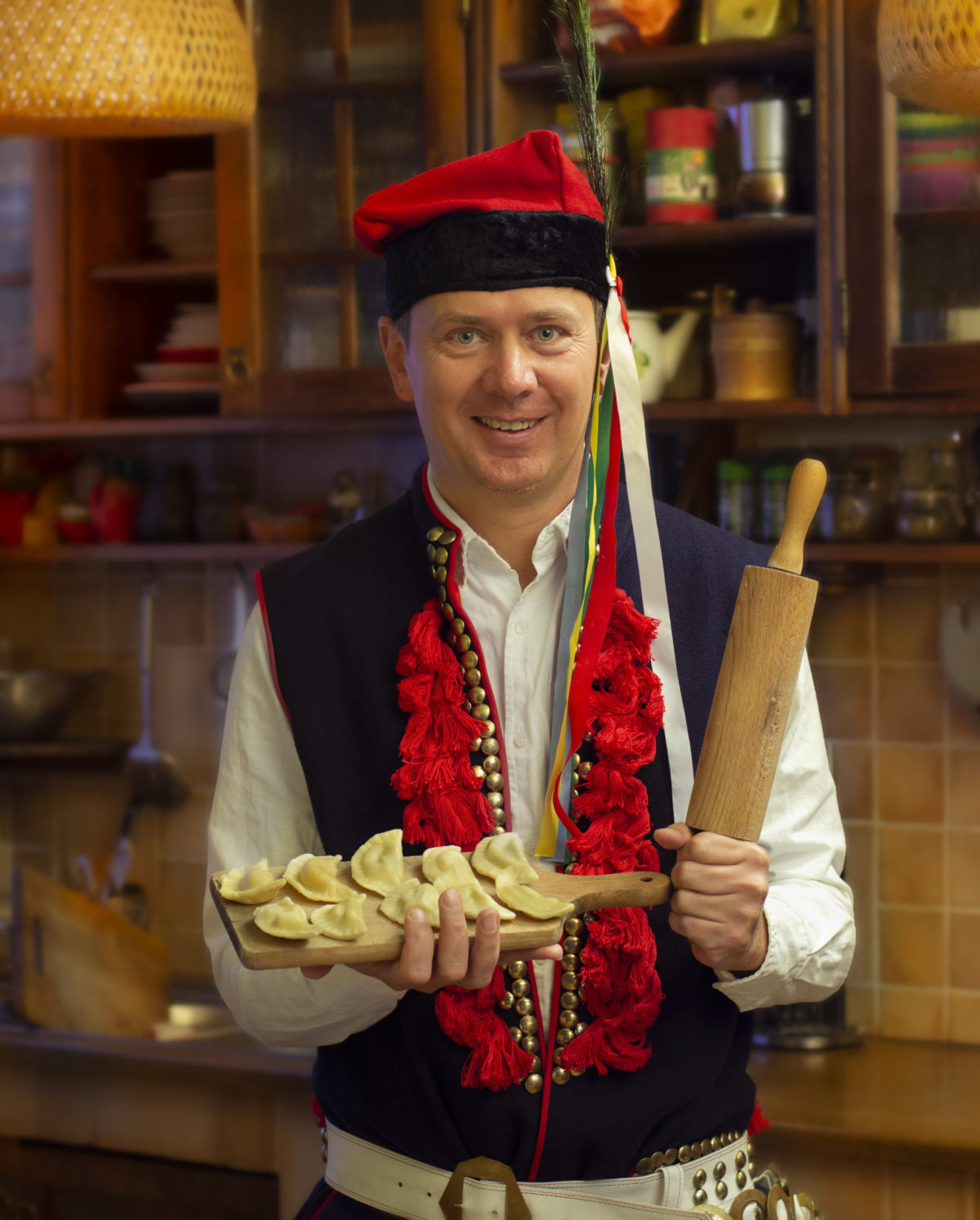“Let’s reach higher.” That’s what Agnieszka Łopata and Andrzej Czech said to each other one day before they moved from the city of Krakow to the wildest Polish mountains, the Bieszczady, which run along the southeast of Poland through Ukraine and Slovakia.
After all, there could be no better location for a creative, environmental engineer from Krakow and a native highlander with a PhD in renewable energy to launch a brewery.
They followed a path shown to them by the Ursa Maior (Big Bear) constellation, which led them straight to a small, isolated village called Uherce Mineralne — where eventually they created a regional brewery named after that same constellation.
Of course, all this did not happen overnight. It took years of hard work and sacrifice. It’s hard to believe that these two enthusiasts went from living in a tent in 2004 to running a brewery. And back then, neither of them had even thought about producing beer.
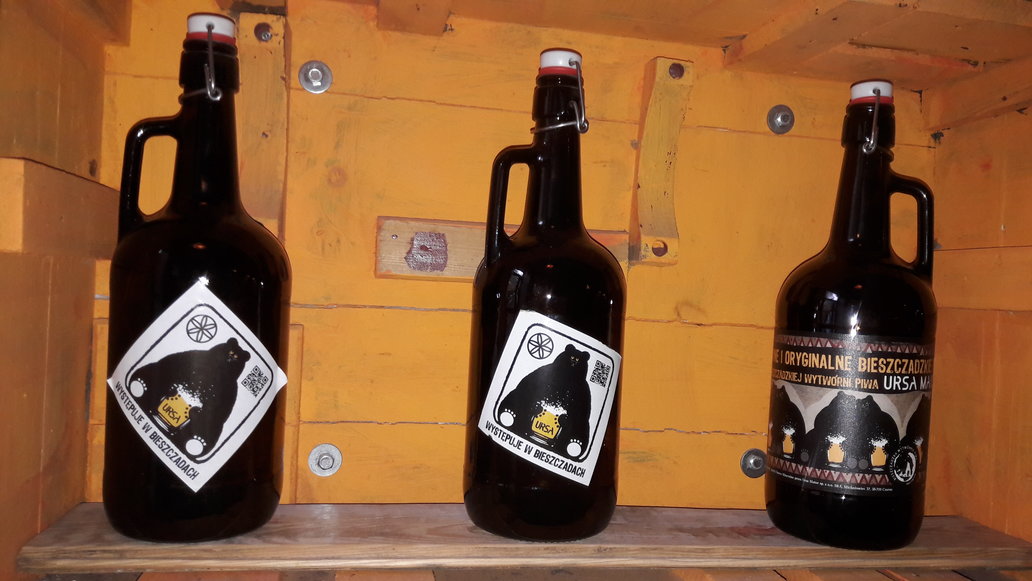
Bottles inspired by the Bear | Photo by Ursa Maior Brewery
Historians say beer was first discovered by accident, in ancient Mesopotamia, and the same miracle happened with Ursa Maior. Agnieszka Łopata, the founder and head of Ursa Maior Brewery, started her beer adventure by buying a small brew kit for home production off the internet. Everything that happened later was a fairy tale and an avalanche of events. Domestic brewing in the bathroom and kitchen was so inspiring that after a few years, her brewing became the well-known Bieszczady Beer Factory, where the ancient song of the mountains can co-exist with modern brewing technology.
The rules imposed by the legendary Bear were, from the beginning, very simple: everything must be local and ethical. This philosophy is not limited to just brewing; even the beer boxes are made in a nearby mill with waste wood, and the property’s grass is left to grow freely so as not to disturb its wild inhabitants. Ursa Maior is also a promoter of local artists, especially those inspired by the art of iconography and mountain music, and hosts many regional initiatives from concerts to art exhibits.
Ursa Maior beer is a unique product made by passionate locals, and is strictly connected to the Bieszczady region. And while you can try it on location in the brewery, you can also find it in plenty of local shops around Poland — as well as in the Ursa Maior pub and store in Krakow’s Kazimierz district, where you can buy bottles inspired by the Bieszczady area.
Want to try it for yourself? Our Made In Krakow tour takes travellers to the Ursa Maior pub to sample some of their beers, alongside tasting boards. If you close your eyes, you’ll maybe even get a sense of the vast wilds of the mountains in every sip. Plus, part of the revenue from beer sales goes back to conservation efforts in the Bieszczady region. Beer with a story and for a good cause? Pour us another one, please.
24 hours in: KrakowThe city of Krakow is a beautiful mix of old and new, as well as history and culture. If you only have one day to discover this fascinating Polish city, make the most of it with these local tips from our Krakow tour guides, packed full of adventure and local know-how for making the most of a mere 24 hours in Krakow.
Early morning (7 – 9am)
Start the day early and walk along the Vistula River, taking in the views (be sure to snap a classic photo at the monument of the Dragon, which is the beloved symbol for the city of Krakow). In the mornings, there are practically no people here, which means the beautiful view is all for you. You can grab a nice and reasonably cheap Polish-style breakfast in the Pod Wawelem hotel, which has a small restaurant and terrace with a panoramic view.
After you’ve eaten, climb nearby Wawel Hill, and visit the romantic courtyard of Wawel Castle. Enter the Wawel Cathedral as close to 9am as possible, just as it opens — that way you’ll beat the tourist groups that flood here each day.
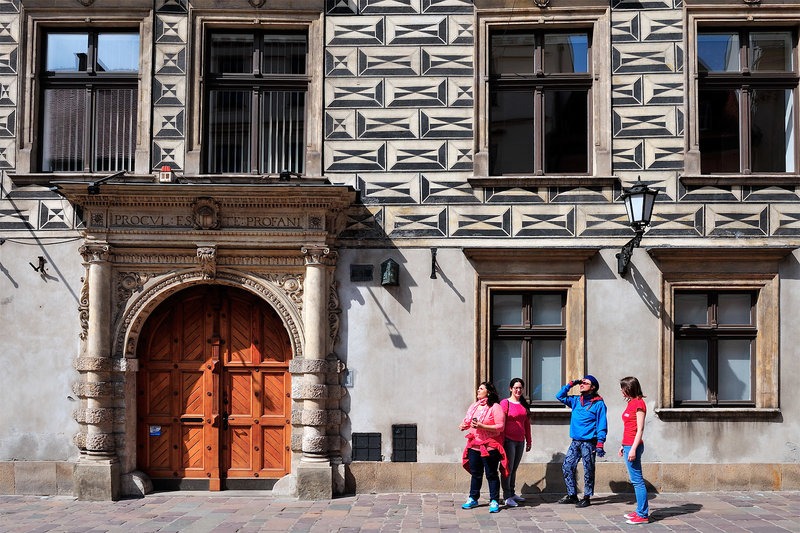
Start your day early and you’ll have some of the major sites all to yourself | Photo by Krakow Urban Tours
Morning (9am – 12pm)
Walk down Wawel Hill towards the Kazimierz district (it’ll take you about 15 minutes). In the past this was a separated part of the city, but now is a popular district with both Catholic and Jewish monuments (it’s also the site of our Changing Faces of Kazimierz private tour, if you wanted to hop on that later in the day!). See the beautiful Temple Synagogue at 24 Miodowa Street, then walk another five minutes to 12 Josef Street, to see the place when Spielberg filmed some scenes from Schindler’s List.
Grab a fresh coffee and something sweet in the courtyard of Mleczarnia Garden or walk a bit further for a short break in one of hundreds of spots around Plac Nowy (New Square). For some suggestions, try French-style Kolory or mysterious Alchemia — you will not be disappointed as they both have interesting interiors and good coffee.
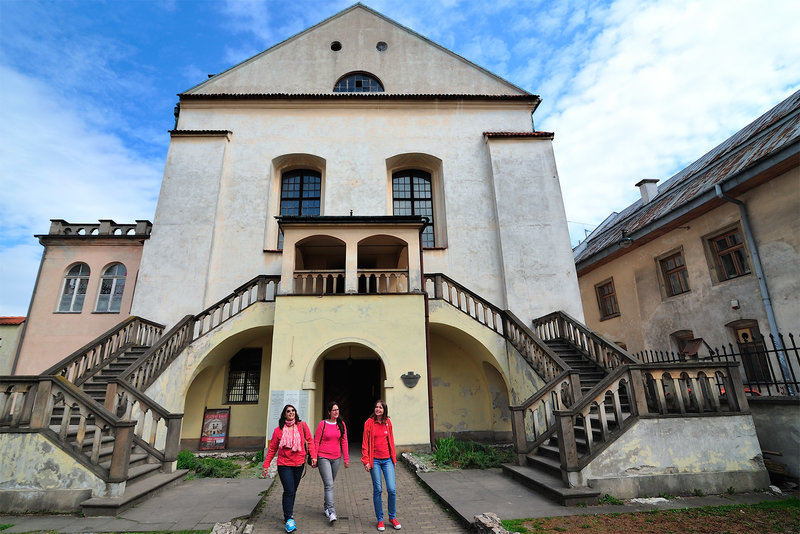
Take your time to explore the unique sites of the Jewish Quarter | Photo by Krakow Urban Tours
Walk towards Szeroka Street, heart of the old Jewish Quarter, which is full of historical buildings and Jewish-style restaurants. Make sure that while you’re here you visit the renaissance Remuh synagogue and cemetery, and you stop to contemplate the story of Helena Rubinstein, the famous Queen of Cosmetics and Lady of Beauty who was born in a small green building situated just in front of the synagogue.
Midday (12 – 2pm)
Take a short walk towards Wolnica Square to see a hidden monument of three musicians and have a typical Polish lunch in the local restaurant Marchewka z Groszkiem (Carrots with Peas), situated at the corner of the market at 2 Mostowa Street. The best choice would be their extraordinary carrot and pea soup and pierogi (of course!).
Take a stroll along the lovely Kladka Bernatka pedestrian bridge and have a coffee or local beer in one of many alternative small bars visible on both side. Have a look at the Main Square of Podgórze district, where you will find the interesting St. Josef church and a pretty local park where it is possible to have a nice rest or picnic among the old trees and limestone rocks.
Afternoon (2 – 6pm)
Take a tram to the city centre and get off at the tram stop called ‘Basztowa LOT,’ then head to the Stary Kleparz food market. It’s the perfect place to get a peek into local life as the residents around you shop for fresh produce, cheeses and other delicious treats — keep your camera handy for great shots of colourful stalls full of fruit and vegetables.
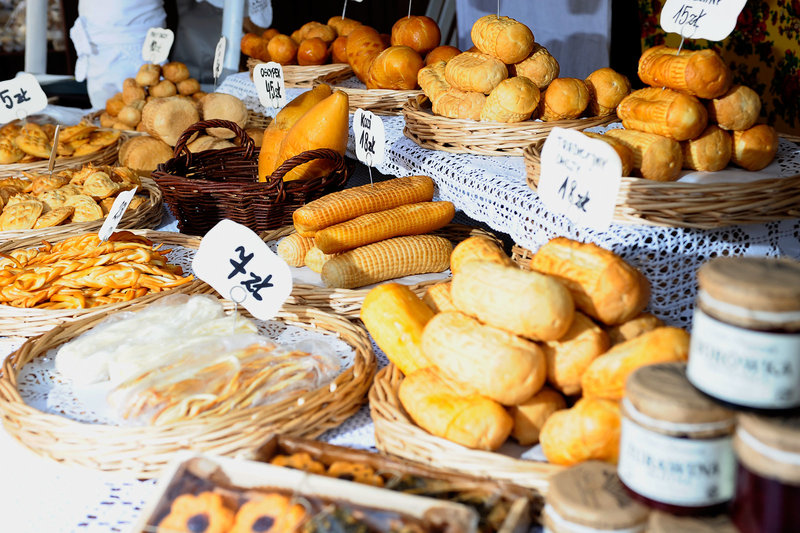
Snap some photos (and shop for snacks!) at the local market | Photo by Krakow Urban Tours
Check out the round, red brick building called Barbacan, then go through St. Florian’s Gate to find yourself very close to the Main Square, where you should be at the exact hour to listen to the trumpeter who plays from the highest tower of St. Mary’s Basilica, a special signal called hejnal to commemorate a legendary victory over the Mongols in the 13th century. This place is always busy, but around 2pm to 4pm there are fewer people, so enjoy visiting the most important monuments like the Basilica inside and the Cloth Hall, a huge local market where you can buy all the souvenirs you need.
Next, go to the Collegium Maius (15 Jagiellonska Street), the oldest building of Jagiellonian University. Visit the monument dedicated to its most famous student, Nicolas Copernicus, at the Collegium Novum nearby and take a deep breath in the beautiful Planty park — a green ring created on the site of the city’s medieval fortifications.
Of course, you could also hop on our Royal Krakow tour, which takes you along the Royal Route and to see the landmarks of Old Town!
Evening (6pm until late!)
After some rest, have an aperitif in Bonobo Café (4 Maly Rynek), where delicious craft beers and a big selection of Polish vodkas are available. After that, head out for a typical Polish dinner at U Babci Maliny (38 Szpitalna Street). For some late-night fun, you can go to the dance and gym studio Kontakt at 40 Szpitalna Street, where you will be sure to find friendly locals and expats who would love to chat and dance the tango (yes, the tango!) with you in one of the many secret places around the city.
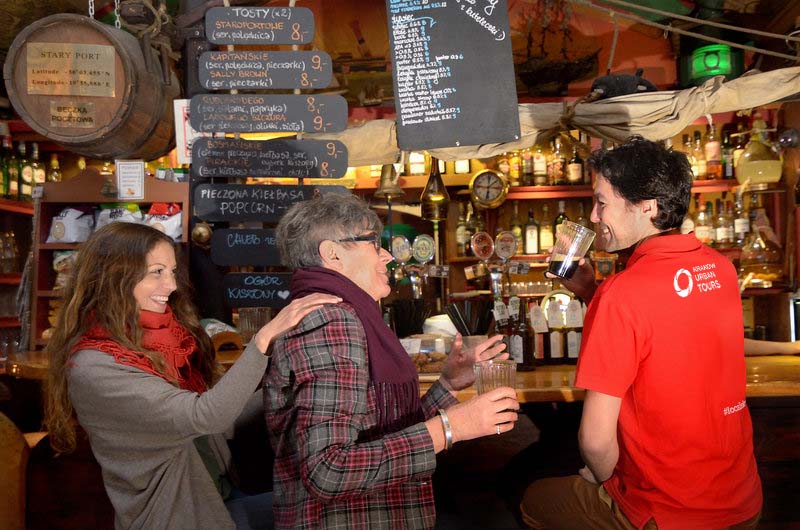
It’s easy to find two things in Krakow: craft beer and new friends | Photo by Krakow Urban Tours
Or you could go see a movie in one of the many centrally located cinemas. All the movies are in their original languages with Polish subtitles, so don’t worry about not following along. The Kino Pod Baranami theatre is a great choice as it has very friendly stuff and ambitious line-ups year round.
Another option for an unforgettable night in Krakow is to head back to the Kazimierz district, known for its nightlife, and spend the rest of the evening roaming local bars, talking to people and dancing. If you feel hungry at some point, don’t miss the excellent smoked sausages and fresh rolls with mustard served right on the street directly out of an old blue communist van at the busy market place Hala Targowa, located between Kazimierz and Old Town.

Grab a fried sausage — you won’t regret it | Photo by Krakow Urban Tours
Shorter stays
If you can’t manage a full 24 hours in Krakow, you can still see the sites within a quick few hours on a stopover — thanks to a fast train line that connects the main railway station and the city centre of Krakow, you’ll only need about four hours total to get from the airport into the city, see some sites and then head back for your airline’s check-in. The train runs every 30 minutes, but we recommend counting on one hour one way, just to be sure. Don’t bother with private cars or taxis, as frequent heavy traffic will hold you up, and the train is much faster.
If you’re in Krakow on a morning or afternoon layover, head to Wawel Hill with its famous royal monuments — it is the place where the heart of all of Poland beats. Visit the monument of the Dragon at the Vistula River, then climb Wawel Hill for outstanding panoramic views and great photo opportunities. Visit the romantic courtyard of the Wawel Castle and enter the Wawel Cathedral to see the coronation place and royal necropolis. You’ll need about an hour to 90 minutes to see the sites.
If your trip has you on an evening or nighttime layover in Krakow, then head to the Kazimierz district, home to lots of Jewish monuments and artistic soul. Kazimierz is the former Jewish quarter of Krakow, where every single home and building has its own fascinating story to tell. It’s a unique neighbourhood where the old and new coexist, where art galleries and cafes share equal space with monuments of Jewish culture. Synagogues and cultural centres stand side-by-side with charming bars and restaurants, while Jewish original inscriptions meet with modern murals, and traditional kosher food can be found alongside Indian or Mexican food trucks. You’ll need about 90 minutes to two hours to get the proper Kazimierz experience.
Ketchup, cheese, liberty: The legend of Poland’s zapiekankaThe zapiekanka (a long, open-faced sandwich) was a beloved piece of my childhood. But not only mine — it was a miracle treat for a whole generation of Polish children who discovered it at the end of ‘80s (and who still buy one from time to time for sentimental reasons).
I will never forget the white trailer that parked close to my family home, and the old lady who sold from its window this first Polish “fast food” — a hot baguette with cheese and mushrooms. Zapiekanka. If I close my eyes I can still smell it, and remember that feeling of happiness, waiting in a long queue to spend the first bit of pocket money offered by my wealthy uncle.
For those who didn’t grow up in Poland, it can be hard to believe that an ordinary piece of bread and toppings became so popular. But in the past, if you could prepare the real-deal zapiekanka at home for a party, you’d feel like a local hero.
Today, zapiekanka is sold with many additional toppings, such as meat, all sorts of vegetables and even pineapple rings, but to be honest, I’m convinced that the traditional version is the best. The secret is to have a fresh baguette, good-quality cheese and mushrooms, and to bake it in the stove instead of in a microwave. And besides, the true flavour of zapiekanka comes from its nostalgia, and no fancy new toppings can beat that.
In our youth, what really shaped the taste of zapiekanka was this special feeling of trying something new and unknown on the one hand, and prohibited and secret on the other. It was the taste of change. The first-ever capitalist fast food in Poland tasted like liberty, and liberty tasted like a mix of ketchup and fried cheese. These were times when pizza, hamburgers or sushi were not available at all, so zapiekanka reigned on the Polish streets and undoubtedly started the street food fashion that is still in progress in Poland.
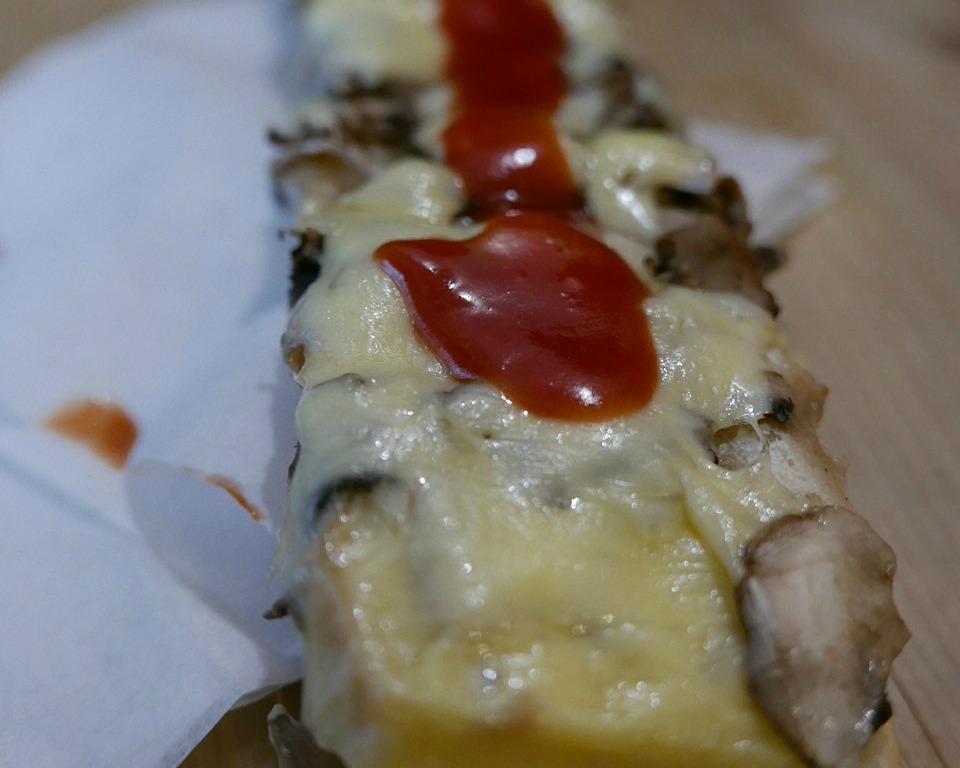
#localsknow where to get authentic zapiekanka | Photo by Krakow Urban Tours
In Krakow, you can buy zapiekanka everywhere, but local residents know that there’s only one place where this special taste has survived the turbulent years of transformation. A microscopic shop in the middle of Sienna Street, a stone’s throw from the Main Market Square, Zapiekanki od 1980 roku still maintains tradition and, since 1980, has been selling true zapiekanka.
Ms Marta opened her shop at a time when the cracks in Poland’s Communist regime were starting to crumble; many say her stall was the first fast food restaurant in Krakow — a place where on-the-go meals were sold, flauting the law forbidding American-style cuisine. Her toasted open-faced sandwiches became a symbol of freedom, and eating one was a way of fighting the regime. Today, Marta’s shop doesn’t hold the same political power, but for the locals who remember, her simple sandwich holds heavy, nostalgic significance.
Even though her tiny shop is open from 10am to 7pm, her busiest time is the lunch rush between noon and 2pm. On any day, you’ll find a range of Krakow locals grabbing lunch — construction workers on break from street projects, professors from the university, actors from the nearby theatre. Don’t be surprised if the person ahead of you in line, sharing local gossip with the owner, is a famous Polish celebrity grabbing a bite to eat.
People come here not just for the best hot sandwiches in the city, but to talk with the women who have been working here for some 30 years, Ms Martha and Ms Anna. For three decades, they have politely listened to all the problems and concerns of their customers; they have shared joys and heartache and seen the next generation grow up. It remains a place where I can go with my own mother and my four-year-old daughter and together we all can have a taste of my childhood and of liberty.
How to find it: 3 Sienna Street. It’s a small street between two of the main tourist points of the city, Main Square and Small Square, and is a one-minute walk from either square. (Psst, Small Square is also the meeting point for our Food by Foot tour.)
What to order: Traditional zapiekanka (no extra toppings!); fresh beetroot juice.
The complete guide to: Krakow travelKrakow Food by Foot
Learn about Krakow through the best local restaurants and bars on this walking tour of traditional Polish food and historical monuments. After all, the best way to understand how to live a local is to eat like a local! Get your first taste of Polish cuisine and local beer over a discussion on Polish gastronomy in Small Market Square.
Anyone considering a visit to culture-filled Krakow would be on the way to making a great travel decision. What you’ll find upon arrival is Europe’s largest market square and a charming Old Town teeming with some of the city’s best attractions, as well as museums aplenty, and parks and green space galore. If you’re planning on visiting, we have you covered with tips from our local Krakow guides on everything you need to know about getting around and what to see and do once you’re there.
Getting to and from KRK
Taking the train is a convenient way to get from the airport into the city. The trains run approximately every 30 minutes to Krakow’s main railway station and also offer free wi-fi. Tickets cost PLN 9 and you’ll need to purchase your tickets in advance at a ticket machine. The train station is located near the passenger terminal, at the rear of the multi-storey car park.
Metered taxis are also available and cost approximately PLN 120 to the city centre. iCar is the cheapest taxi company and it’s usually cheaper to order a cab by phone. Another option, is if you’ve scheduled a tour of Krakow with Urban Adventures, we’re happy to arrange a private car for our visitors.
Getting around Krakow
Walking: Best way to see Krakow? Break out your comfy shoes and walk! Not only is it free, but the majority of the city’s landmarks in the Old Town are within easy walking distance.
Public transit: The city is served by buses and trams (tickets are the same for both) and public transit is available 24 hours a day. Cost depends on the type of ticket you require with the cheapest fare being good for 20 minutes at a cost of PLN 2.80 (enough to go five to eight stops). The price goes up for length of travel and you can also purchase tickets for 24, 48, and 72 hours, depending on how much you’ll be using public transit.
You also might want to think about picking up a Krakow Tourist Card, which gets you free entry to over 40 Krakow museums and free travel on trams and buses, day and night (including to Wieliczka Salt Mine). Two and three-day cards are available for PLN 100 and PLN 120, respectively.
Taxi: Metered taxis are available in the city. A typical journey costs approximately PLN 30-40. Remember, it’s cheaper to order a taxi over the phone in advance and iCar Taxis are one of the cheapest companies currently available.
Bike: Renting a bike is also an option for getting around Krakow if you prefer sightseeing on two wheels.
Things to do in Krakow
Krakow’s historic Old Town earned its spot on the first-ever UNESCO World Heritage List in 1978. Just exploring the cobbled streets without a fixed agenda is well worth your time, but you’ll also come across beautiful churches, impressive museums, and Europe’s largest market square. The city’s Old Town is also home to Wawel Castle, the National Museum, St. Mary’s Basilica, Church of St. Anne, the interesting Pharmacy Museum, and small but worthwhile Krakow Poster Gallery (home to over 2,500 Polish posters).
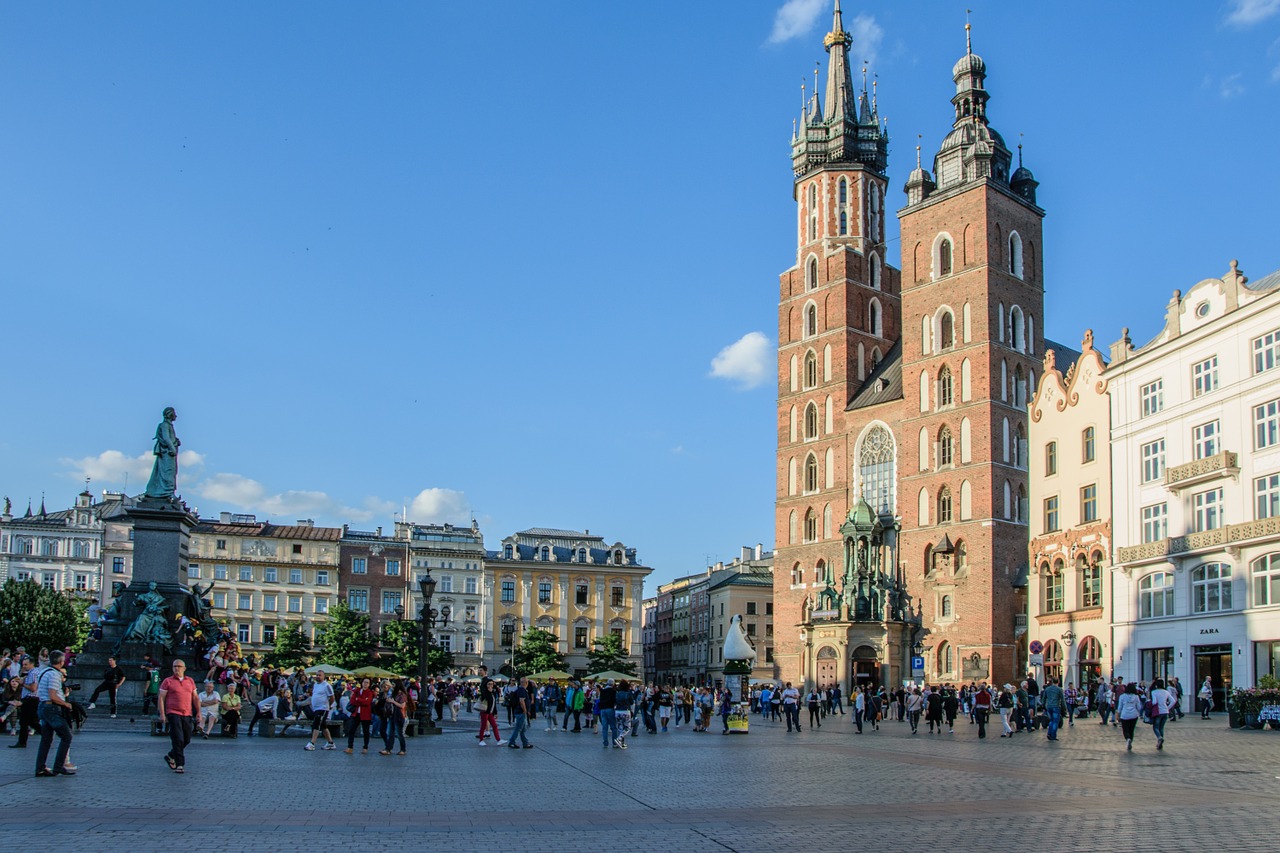
Krakow’s scenic Old Town | Photo via Pixabay.com
Known as the lungs of Krakow, the Planty consists of three kilometres of public parks and gardens filled with trees, flowers, benches and historic monuments surrounding the Old Town. It takes about an hour (or more depending on how fast your walking pace is) to traverse the entire area, but it makes for a pleasant and relaxing way to see the city.
On a visit to Krakow, you don’t want to miss seeing the historic Jewish district of Kazimierz, one of the city’s most exciting neighbourhoods. This is where contemporary Jewish culture comes alive, and in addition to colourful street art, chic cafés, cool art galleries, interesting museums, and some of Krakow’s best bars, you’ll also find numerous synagogues and Jewish cemeteries. Kazimierz is also where the huge annual Jewish Culture Festival takes place. If you want to explore the city on a guided tour, hop on our private Changing Faces of Kazimierz tour.
Krakow is known as Poland’s cultural capital — and rightly so. There are music, film, theatre and arts festivals going on in the city year-round, and especially during the summer. Consider timing your visit to include Misteria Paschalia (focusing on renaissance and baroque music), the Krakow Film Festival, the Summer Jazz Festival, the International Street Theatre Festival or the Sacrum Profanum Festival, focusing on contemporary music.
If you have time, it’s worth heading outside of Krakow to visit Wieliczka Salt Mine, a UNESCO World Heritage site famous for its deep salt mine where everything you see has been carved by hand from salt blocks. Mined since the 13th century, the cavernous mine is spread over nine levels and contains kilometres of galleries featuring works of art, altars and statues sculpted in salt. Visitors are guided in groups and tours take about two hours. Wear comfortable shoes.
Krakow Day Tours
Looking for more things to do? Urban Adventures offers day tours in Krakow, all led by local experts that will give you a taste for local life:
Markets & Flavours of Krakow
Get a taste for local life with this sightseeing-meets-food tour that tells the story of Krakow through its markets and squares. Explore historic districts, see iconic sites, sample local delicacies, hang out in hidden cafés, and take a sip of that famous Polish vodka while learning why the markets aren’t just places to shop — they’re the soul of Krakow!
Krakow Food by Foot
Taste the real Krakow on this food tour of the best Polish bites and sites! Sample traditional fare of pierogies, zapiekanka, and oscypek at local hideaways and explore Krakow’s bustling markets and neighbourhoods. The perfect balance of cuisine and culture for a truly authentic local experience!
Made In Krakow
This Krakow tour will take you to the shops and galleries you’d never find on your own, and connect you with the people it’d be impossible to meet without a guide by your side. See the art they’re making for a living, hear the stories behind their crafts, and go home with a piece of Krakow in your pocket.
The Changing Faces of the Kazimierz Jewish Quarter Private Tour
Give yourself over to the bohemian charm of Krakow’s beloved Kazimierz district and get a firsthand look at why the vibrant neighbourhood is an essential part of the Krakow experience. On this private tour, you’ll eat, shop, and explore your way through the day, learning about the Jewish history of Krakow as you go.
Home Cooked Krakow
What? You haven’t tried Polish food? It may not be as famous as some other country’s cuisines (we’re looking at you Italy!) but it’s just as delicious. Join this Krakow tour to get an inside guide to cooking Polish food in the home of a local home cook.
Nowa Huta Communist Experience Private Tour
Being in the Nowa Huta district of Krakow is like travelling back in time — all the way back to the communist era. The places you’ll visit on this private tour are exactly as they were during the communist regime, in this neighbourhood built as a model communist city.
Beers & Cheers Private Tour
Raise a pint at some of the best-loved local pubs and breweries in Krakow while learning about the long history of beer in the city on this private tour. In between beers and bites, explore the Old Town off the beaten path, discovering hidden corners most visitors never find, and delve headlong into beer culture in Krakow.
Krakow on the big screen
Before you visit, learn more about Krakow by watching Schindler’s List. Liam Neeson stars in this powerful film as the greedy German businessman who ends up saving the lives of thousands of mostly Polish-Jewish refugees from the Holocaust. In Angel in Krakow, an angel falls in love with the city, after mistakenly ending up in Krakow as punishment for liking rock and roll. These films show the real Krakow in the past and present.
Krakow on record
Get in the mood for your trip to Krakow by listening to the band Kroke, a Polish instrumental ensemble of Jewish Klezmer music. Brush up on your classical music with Capella Cracoviensis, a world-class contemporary classic musical group and choir.
Krakow in books
Dive into Krakow before you arrive by reading real and fantastic history of the city. Read Schindler’s Ark, the Booker-prize winning novel by Thomas Keneally, which was adapted into Schindler’s List. The novel tells the story of Schindler, the German industrialist who grew into a living legend to the Jewish people of Krakow.
Kacper Ryx by Mariusz Wollny is a Polish historical crime novel featuring historical characters, including Polish poets Mikołaj Sęp Szarzyński and Jan Kochanowski.
Get in touch with us
To find out more about your trip to Krakow or to book an Urban Adventures tour, you can reach us by phone at + 48 665 015 665 or email us for more information. You can also follow us on Twitter or Instagram, or like us on Facebook.
Krakow Urban Tours
Walking through Krakow is like strolling through your very own open air museum. Around every corner you’ll find something of interest, whether it be a beautiful building or a cool food truck selling traditional Polish fare. Get to know the local way of life in this gorgeous city on a Krakow tour filled with history, culture, food, and even a bit of local lingo if you’re looking to learn it!
The charm of Krakow is best experienced from inside one of the city’s cosy cafés, with a warm cup of coffee in-hand — and the following places are some of Krakow’s best for enjoying your daily dose of caffeine. Grab a seat, watch locals go about their day, enjoy decadent desserts and indulge in some of the city’s best brews at these Krakow coffee shops loved by locals.
Szara Resto & Bar
For delicious coffee in the city centre of Krakow, at Main Market Square (Rynek Głowny), head straight to Szara. You might think because of its location that only tourists come here, but this isn’t the case. The café is an extension of a well-known restaurant nearby and its entrance is a bit hidden, so only a few in-the-know (or just lucky) travellers get there on their own. Local citizens, on the other hand, have long been visiting Szara for fresh coffee and tasty, nutritious breakfasts at a good price. (Breakfasts are served daily, up to 12pm.) I personally recommend grabbing a window seat, as then you can look out over the hectic Rynek Głowny from a safe distance. 6 Main Market Square.

For a taste of Lisbon in Poland, head to Cafe Lisboa | Photo by Krakow Urban Tours
Cafe Lisboa
Be sure to come to Café Lisboa in the heart of a cold Krakow winter because, as its name says, this café can virtually carry you away to the sunny capital of Portugal. The place offers a good choice of delicacies, all made according to traditional recipes from Lisbon. The decor brings to mind one of the cafés of the Belem district: blue tiles, fado music in the background, and above all the delightful smell of freshly brewed coffee and that delicious Portuguese dessert, pasteis de Belem, made on the spot. The owner of the place, Marta Kirsz, loves Lisbon and spent a lot of time there studying the art of baking and she has really managed to recreate that Portuguese vibe (and those tarts!) in Krakow. 3/4 Dolnych Młynów Street.
Meho Cafe
If you dream of finding an enchanted garden in the middle of the city, Meho Cafe is the place for you. It offers a pleasant and colourful interior year-round, but it fully blooms in springtime thanks to a big and shady garden where you can forget the hustle and bustle of the city. It’s an ideal place to drink good coffee and eat a piece of homemade cake. During lunch hours, Meho serves a soup or nutritious kaszotto (the Polish version of risotto, which uses buckwheat or barley in place of rice). Do not miss the interesting anti-war mural on the wall of the neighbouring tenement house. 26 Krupnicza Street.
Les Couleurs
Plac Nowy is full of great places where you can have a coffee or a snack, but I am personally in love with the French-style café named Les Couleurs. In addition to enjoying its Parisian atmosphere and original interior (packed with cinema posters and photos of French actors), you can have a good coffee or tea — or even a decent glass of wine or something stronger. They also serve small snacks such as salads, toasts and homemade cakes. Because Les Couleurs opens its doors quite early (around 8am), it is one of the few places in this sleepy, local area of Kazimierz where you can grab a quick coffee before the rest of the city wakes up. Enjoy it at the bar while reading the day’s news alongside the local artists (or at least those who consider themselves so) who gather here in the mornings. #localsknow tip: The toilet here is worth seeing. 10 Estery Street.
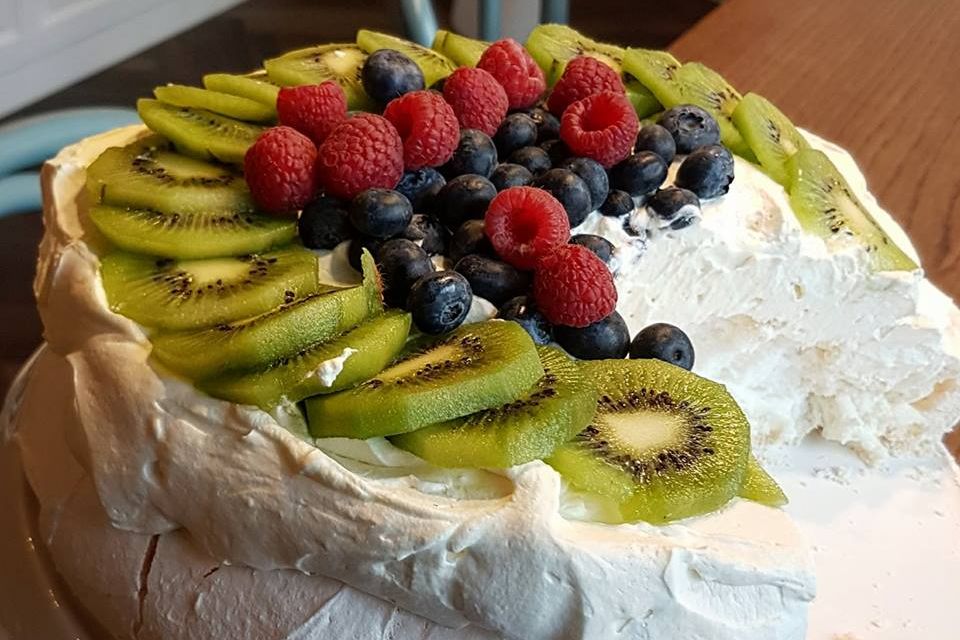
Grab a slab of homemade cake at Crico | Photo by Krakow Urban Tours
Crico Cafe
The name of the café refers directly to the building in which it is located: the freshly created Cricoteca, which is an amazing place associated with the brilliant Polish artist and theatre director Tadeusz Kantor. You can come here after visiting the exhibition (or not) for good coffee and delicious, homemade cake of fruit or chocolate. Crico Cafe offers one of the best views in the city due to its location in the Podgórze district, just on the bank of the Vistula River. Several districts and all the most important monuments of the city can be seen from here. The interior is also worthy of photo-taking, so bring your camera; you will rarely see something so lovely while drinking coffee. 4 Nadwislanska Street.
A vibrant café culture, a UNESCO-listed Old Town steeped in history, plentiful parks and an exciting nightlife are just a few of the reasons to pay a visit to Krakow. But with so much to take in as a tourist, it can be easy to forget you’re a guest in the locals’ home. To make the most of your trip while also minimising your travel impact, we suggest keeping the following tips in mind. Not only will the local appreciate your efforts, but you’ll end up having a better experience of the city and local life.
Practice street smarts
When visiting Krakow, it’s always a good idea to walk on the right side of the sidewalk as you explore, and when you’re crossing the street, use proper pedestrian crossings rather than trying to cross just anywhere. Also make sure the light is green when you start crossing. It’s not only common sense that puts safety first, but also protects you from the steep fines fines given by the city guards (Straż Miejska) if you cross when and where you’re not supposed to.
Public transit tips
While riding the tram or the bus, remember to stamp your ticket in the small machines on board. Be sure to do it immediately after getting on, to avoid a potential fine if there is an inspector around.
If there is no place to sit when you get on a bus or tram, make sure to stay away from the door so you don’t disturb people who want to get off at the next stop. It is also seen as rude to talk loudly, use your mobile phone, or to eat on public transport,
Be polite when taking photos
In many monuments and museums you can’t take photos with a flash, or in some, like St. Mary’s Basilica or in the Wieliczka Salt Mines, a special payment is required if you want to take pictures. Other sites, like Wawel Cathedral, do not allow photos at all. Ask your Krakow tour guide or a local if it’s okay to take photos before snapping any pictures. It’s also important not to take any photos in religious places while there is a service going on.
Dress for respect and practicality
There is no special dress required to visit Krakow, but there are some places like Catholic churches or Jewish synagogues where you will be asked to cover your knees and arms when sightseeing. If you are going to visit a very elegant restaurant in the city centre or attend a theatre performance, it is a good idea to wear something more than just a t-shirt and leggings. While it’s not forbidden to enter while wearing casual clothing, you might feel strange if everyone else is dressed more formally. In addition, if you plan on doing any trekking in the nearby mountains or visiting the Wieliczka Salt Mines, don’t forget to take warmer clothes, comfortable shoes and a raincoat as the weather can change quickly.
Shop and explore like a local
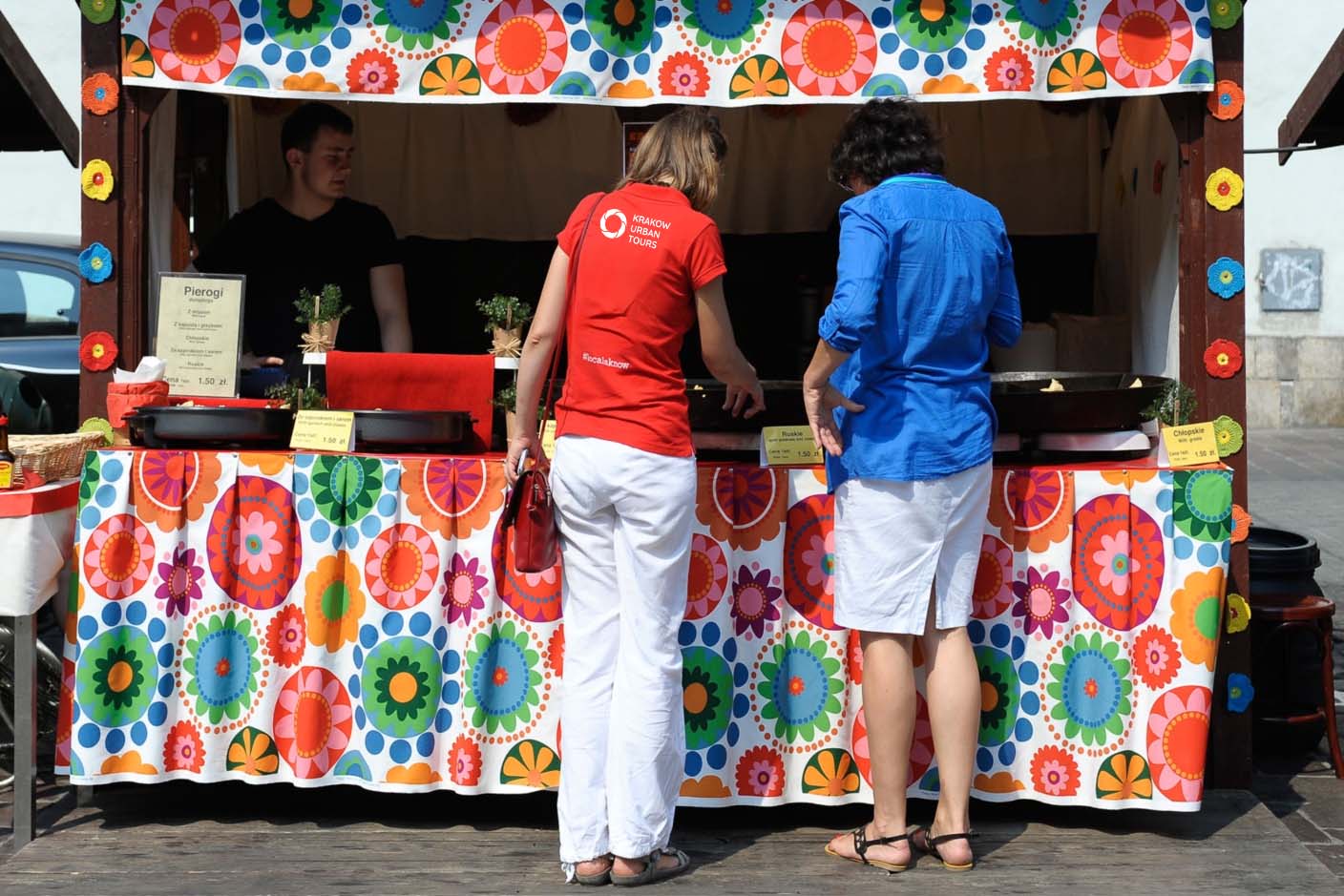
Make time to shop local in Krakow | Photo by Krakow Urban Tours
There are many handmade products like amber jewelry or Polish pottery available around the city centre of Krakow. If you want to go deeper into local products, take our Made in Krakow tour with a guide who will take you to our favourite local galleries and small, locally owned shops selling clothing, leather products, jewellery and more.
In terms of more touristy sites, it is our subjective opinion, but the interior of Wawel Castle can be skipped as the monument is more fascinating to see from the outside than the inside. It’s a good option for rainy or cold weather, but on sunny days, it is much better to visit the up-and-coming Podgórze district, or climb Krakus Mound for amazing panoramic views of the whole city.
There are many local, extraordinary neighbourhoods to visit while in Krakow. We especially recommend Podgórze, Debniki and Zwierzyniec, where you will be surrounded by beautiful parks, historic homes and local, colourful markets full of fresh and tasty products.
Be season-smart
Krakow is a beautiful city all year round, but if you want to avoid crowds, we suggest visiting in the spring or early autumn. Usually the weather is very nice for sightseeing and all the monuments are more accessible than in June or July. If you like winter, Krakow in December is nice if you want to visit the Christmas markets. January and February can be cold but still offer the chance for quieter sightseeing. Our local secret for feeling good and warming up during this time of the year is to enjoy a lot of hot soups, hot wine or even hot beer.
In the summer between May and August, Krakow is quite crowded, but still less so than some of Europe’s top destinations. If you want to sidestep crowds during this time, it’s a good idea to visit the highlights of the city like Wawel Castle, Schindler’s Museum, etc., immediately after they open or (even better) one hour before closing time. Make sure to book your tickets in advance online to save time, rather than waiting in long ticket lines.
Be an eco-visitor
Reduce, reuse, recycle
Krakow is a clean city and in many places around the city centre you will notice special litter bins for separating waste. You can easily avoid single-use plastic bottles as our tap water is drinkable and available for free in the majority of local restaurants.
Avoid food waste
If you ordered too much food and want to help the local community, you can always leave uneaten items in one of our many social refrigerators, available for people who need them. The one closest to the tourist areas is in the Kazimierz district at 28 Paulinska street. A list of others is available on the Foodsharing Krakow Facebook page.
Put your feet to work
Krakow is a great city for pedestrians and you can also use public bikes to get around, which are available in many places around the city. There is detailed information in English about how to register with bike-sharing systems like Wavelo. Taxis, Uber and private cars are quite expensive, contribute to traffic, and increase pollution. If you don’t feel like walking or riding a bike, try to stick to public transport, which is cheap, local and available even during the night.
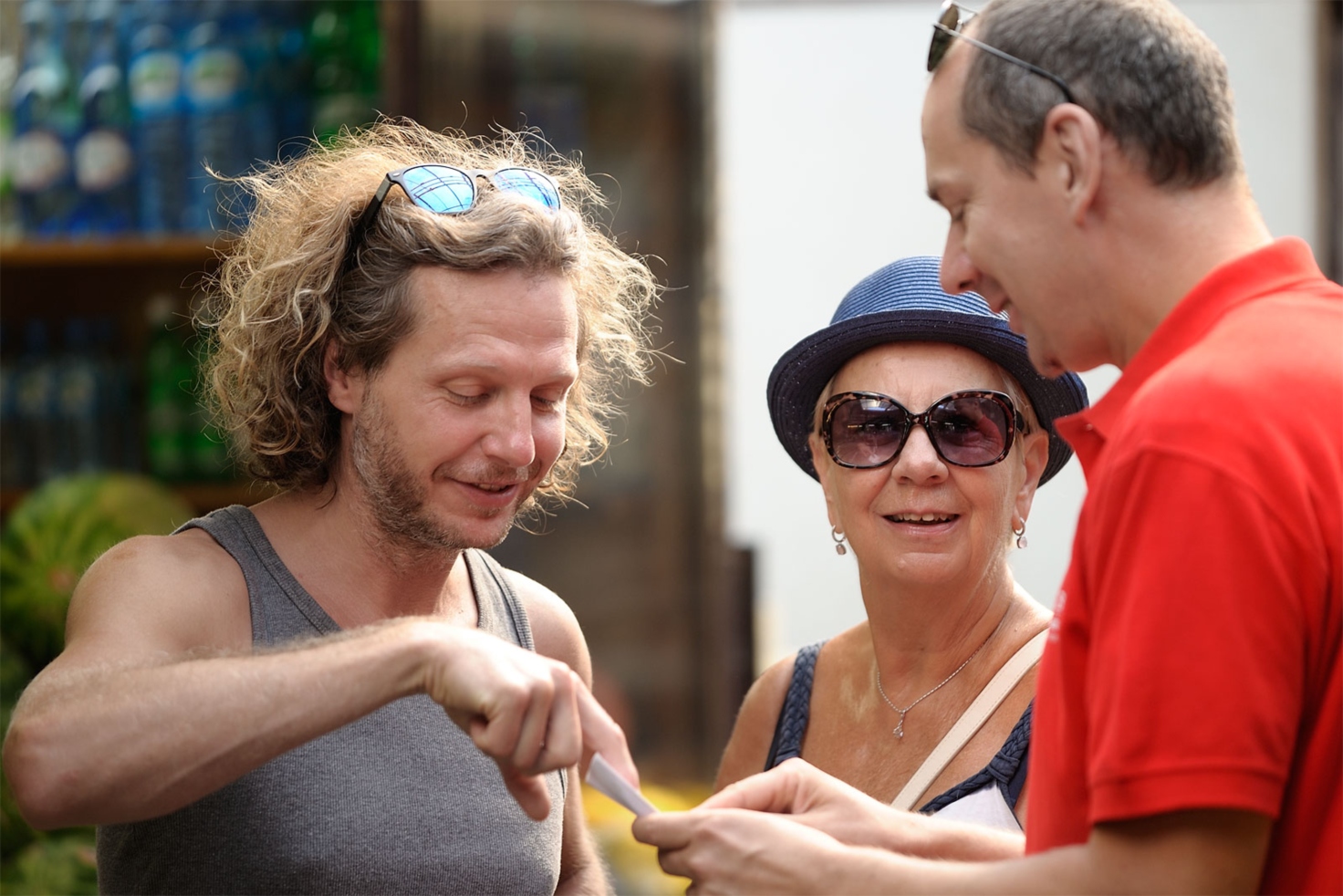
Practicing Polish with the locals | Photo by Krakow Urban Tours
Learn the lingo
Making a small effort to say ‘hello’ and ‘thank you’ in Polish can make all the difference for showing your respect to locals. Keep these phrases in your backpocket when you’re wandering around Krakow:
- yes = tak
- no = nie
- hello/good day = dzień dobry
- goodbye = do widzenia
- thank you = dziekuje
- cheers = na zdrowie
- Please do not add straws to my drink = proszę napój bez słomki
Keep these tips in mind and you’ll be feeling – and acting – like a local in no time! And of course, don’t forget to hop onto one of our locally led Krakow tours for even more insight into life in this fascinating city.
Best places to drink in KrakowRaise a glass at some of the best-loved local pubs and unique watering holes in Krakow. Here are some of the best places to drink in Krakow, where you can sample regional beers and Polish vodka, or hang out in a true sailors’ tavern.
Ursa Maior pub
Inspired by the Ursa Maior (Big Bear) constellation, Ursa Maior beer is a unique product made by passionate locals, and is connected to the wild Bieszczady region. And while you can try it on location at the brewery, you can also find it in the Ursa Maior pub and store in Krakow’s Kazimierz district.
Our Made In Krakow tour takes travellers to the Ursa Maior pub to sample the beers. If you close your eyes, you’ll maybe even get a sense of the vast wilds of the mountains in every sip. Plus, part of the revenue from beer sales goes back to conservation efforts in the Bieszczady region. Beer with a story and for a good cause? Pour us another one, please. 10 Wolnica Square.
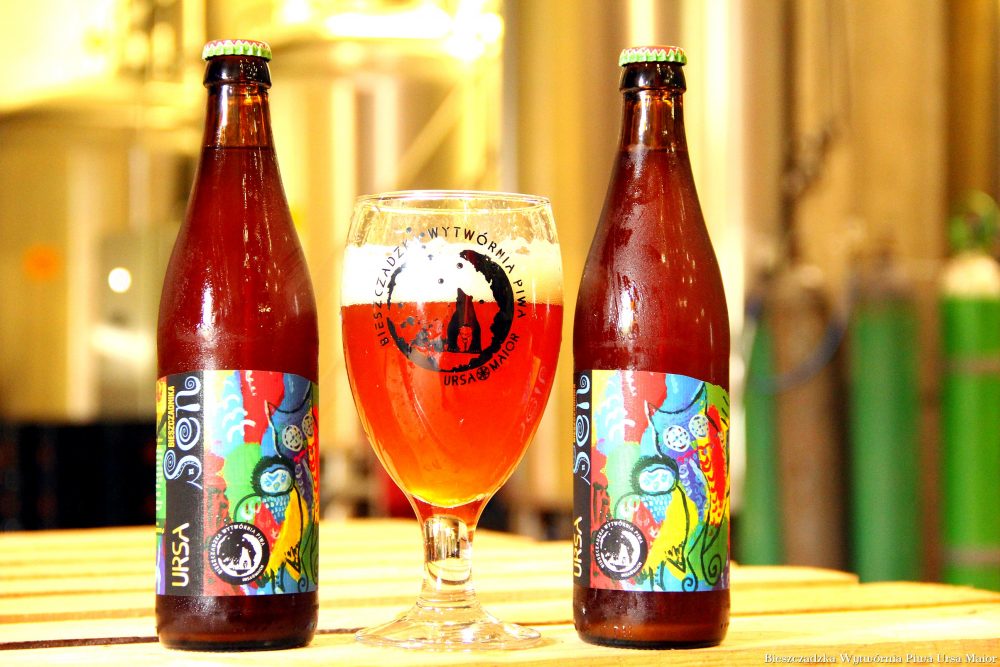
This beer is inspired by the Ursa Maior constellation | Photo by Krakow Urban Tours
Bonobo
A visit to Bonobo will leave you feeling like a better world exists. While you can come to listen to great music while enjoying a cup of coffee and a vegan cookie, it’s best to sample one of the many regional beers Bonobo serves. The Red and Black Cat strong lagers are worth trying. Enjoy a drink in the hidden garden, or at the bar while debating social issues with Bibi (Bonobo’s barman and one of the most recognisable locals in the city). Interesting meetings, concerts and discussions take place almost every night. All of this surrounded by important and valuable books from around the world, sold in the bookstore which is an integral part of the place. 4 Small Market Square.
Mleczarnia
Mleczarnia actually consists of three venues — and every single one is amazing. There’s a regular pub, with a nice interior just behind the corner of the famous New Square. There’s also a great summer garden located nearby in the middle of the courtyard, where Spielberg filmed Schindler’s List. Finally, what I like best: a hidden cafe at the bottom of the Centre for Jewish Culture, connected with the roof garden. You get panoramic views of the whole Kazimierz neighbourhood from there, and the best part is that so few tourists know about it.
READ: A local’s guide to Kazimierz, Krakow
Krakow Urban Adventures ends our food tour here with a piece of a nut cake (a local specialty) and we say goodbye in the Polish way — meaning everyone enjoys a shot of Bison vodka. If you’re a fan of strong liquors and vodkas, Mleczarnia is an ideal place for you. Besides Zubrowka (Bison vodka), they also have a good selection of flavoured Soplica vodkas. Try the cherry flavour, and maybe order a taxi in advance, as Polish vodka is strong. You won’t win a drinking competition with the locals! 17 Meiselsa Street.
Alchemia
Fair warning: they don’t like hordes of tourists at Alchemia, so either go alone or with a few friends, not with some 30 people following behind. It’s a super cool place to have a local beer or coffee, with the interior made to resemble a private home set in the past. Vintage furniture, a doorway made out of a wardrobe, candles and old family portraits on the walls create a cosy atmosphere. Come to listen to live music in the hidden basement. If you like modern jazz, you won’t be disappointed. 5 Estery Street.
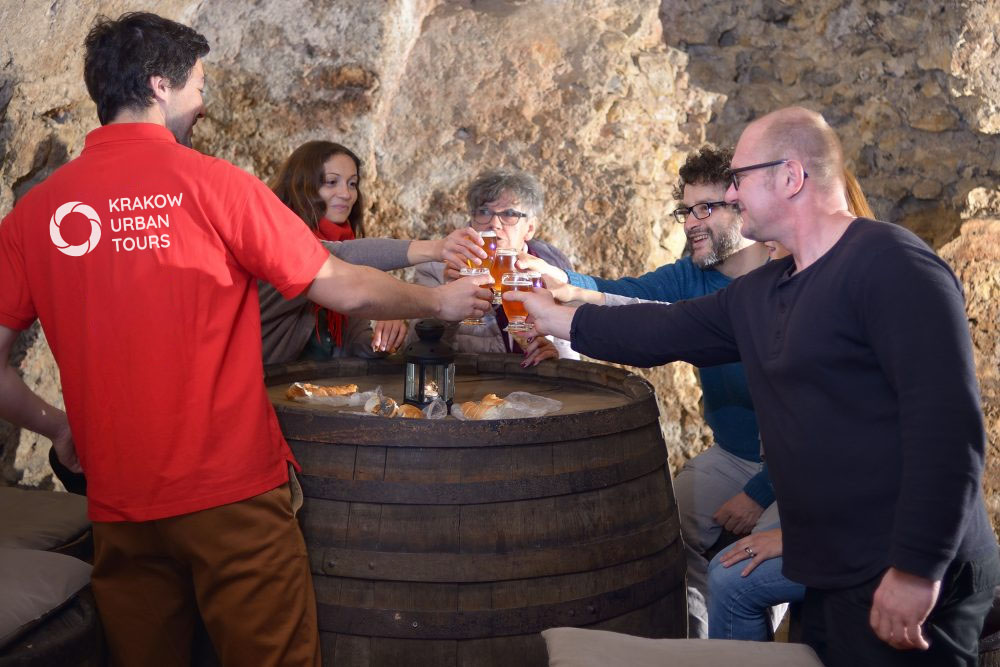
Raise a glass at Piwnica pod Baranami in Krakow | Photo by Krakow Urban Tours
Piwnica pod Baranami
An amazing place connected with the cabaret of the same name, Piwnica pod Baranami was created as an antidote to the communist country by founder, Piotr Skrzynecki. The spirit of Piwnica pod Baranami (Cellar under the Rams) is reflected in the words of the artist himself, “We are an island in the sea of bestiality, drabness, stupidity, villainy, cynicism, intolerance and violence.” The cabaret exists to this day, with performances taking place every Sunday. On other days, you can see different types of performances and concerts, and on Wednesdays, dance the tango.
READ: Forget the folk songs; in Poland, locals dance the tango
During the day, grab a craft beer, wine or vodka, along with typical Polish paluszki (similar to pretzel sticks) and admire the original decor, including pictures from old performances and stage props. It’s also worth listening to the lyrics of the original songs, although they are sung mainly in Polish. The songs reflect the atmosphere of the place and will persuade you to stop and pause for a moment. 27 Rynek Główny.
Stary Port
Walk five minutes from the Rynek Główny (Main Market Square) and find yourself in totally different reality. Stary Port (Old Harbour) is a true sailors’ tavern, situated on the outskirts of the medieval university district of Krakow. The stunning interior is all about sailing and cruises; the taven is decorated with old maps and navigation tools, and serves alcohol strong enough for any sea-goer. Each February, the Stary Port pub hosts the International Shanties Festival. There’s always plenty of live music events and sailors’ meetings at other times of the year. Why does a sailor’s tavern exist in the middle of a city connected by mountains, with no access to the sea? Don’t ask. This is Krakow, where magic is in the air. 27 Straszewskiego Street.
The 12 dishes of a Polish Christmas dinnerChristmas is the most celebrated feast in Poland, and while the day is traditionally considered a religious holiday, the fact is most people here celebrate it in some way regardless of their religion. For many Poles, this is the one time of year when all members of their families come together at the dinner table, close to a beautifully decorated Christmas tree, of course.
For us, the most important day is Christmas Eve (December 24th). On this day, families gather to eat a traditional Christmas dinner, which starts exactly after the first star is seen in the sky. The table is covered with a white tablecloth, placed atop some hay — a symbol of the fact that Jesus was born in a manger.
Once everyone is seated at the table, the head of the family acknowledges the group and then everyone shares a wafer, called opłatek, and offers good wishes for the coming new year. Only then do we start eating — but once we start, we don’t stop! A typical Christmas Eve dinner involves some four to five hours of eating, with just short breaks in between!
Traditionally, there are 12 dishes served over Christmas Eve, symbolising the 12 apostles as well as the 12 months of the year. It’s said that you should ensure you eat at least a little bit of everything so that you’ll be blessed with prosperity in the new year.
The first course is always a soup. It is either beetroot soup with small mushroom-filled dumplings (uszka) or mushroom soup with noodles. Then the dinner continues with regular Polish dumplings (pierogi) with various vegetarian fillings (our Christmas menu may be different from what you expect, as it includes no meat). We also serve carp, which may be fried and accompanied by potatoes and vegetables, or served cold in gelatin (the so-called Jewish style). Carp isn’t the only fish we eat on this special evening, as you’re also likely to find herring fillets in oil or herrings covered with cream, served with potato salad. Later on, there will be sauerkraut with mushrooms or cooked together with beans, and eaten with bread.
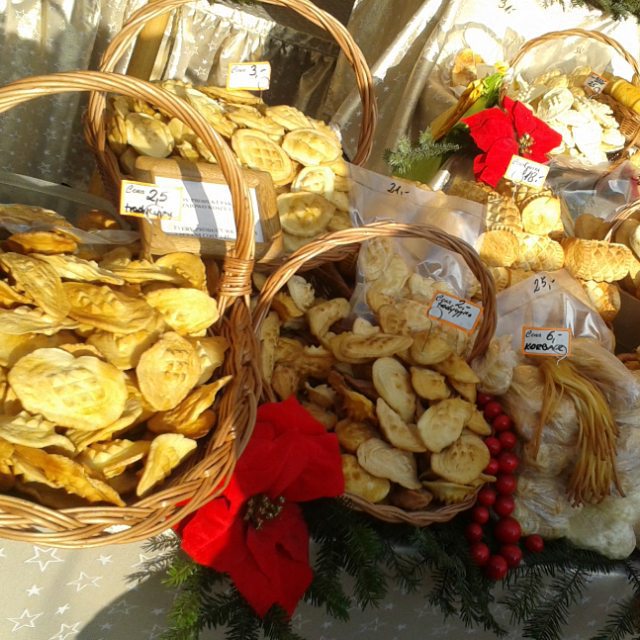
Who could say no to a basket of Christmas cheese?! | Photo Credit: Krakow Urban Tours
It might be hard to imagine, but after all that, the dinner still continues! Except now, we turn to sweeter dishes. The menu differs by region, but typically in Krakow, we have kutia, which is a mix of honey, dried fruits, poppy seeds, and wheat grains sometimes served with noodles, poppy seed cake, and gingerbread with almonds and raisins.
I know that there is a stereotype that Poles drink a lot of vodka but at this time of year, vodka isn’t the drink of choice. Instead, we finish the dinner off by drinking kompot, a non-alcoholic beverage made from dried fruits, as we sing Christmas carols.
Pierogi – the only Polish dish patronised by the saint.Pierogi – the only Polish dish patronised by the saint.
If you’ve ever eaten pierogi, chances are fairly good that you fell in love at a very first bite – and we wouldn’t blame you. But if you’re wondering where this popular Polish dish originated, we have a secret to reveal.
Pierogi are pierogi – there is no better world for this famous Polish dish, although some people try to translate the name as Polish dumplings, Polish raviolis or even small empanadas – none of which are accurate. For us, it is a national dish – something unique and integral to our culture. You can picture pierogi as half-circular dumplings stuffed with many types of different fillings, made out of unleavened dough, and then boiled. The most classical fillings are cheese and potatoes, cabbage and mushrooms, or different type of meat. For Polish people though, it is also ok to have as a main course (not dessert!) sweet pierogi filled with strawberries, blueberries or any fruit of your choice. Once a year, you can find even more offbeat fillings like marzipan with poppy seeds or turkey with peaches or… anything you can imagine to have inside such a small thing like pierogi. This special occasion is the Pierogi Festival we celebrate in Krakow in the middle of August to honour the legendary, patron saint of pierogi: St. Hyacinth, the first Polish Dominican monk.
According to legend, when he was travelling to Krakow to settle down and create the first Dominican congregation at the beginning of 13th century, he was stopped in a village nearby by a huge thunderstorm and he had to spend the night in the local house. He found the peasant and his family very sad because, due to the awful weather and heavy wind, all the crops were totally damaged and they were afraid there would be nothing to collect and they might die of hunger in the wintertime.
So St. Hyacinth promised to help and proceeded to spent the whole night praying to God and asking for mercy. In the morning, a miracle allegedly happened and the villagers discovered that the whole agricultural area had been reborn and they could come back to their fields and cultivate crops. They were so happy and grateful to St. Hyacinth that they took wheat and barley, made flour, and prepared for St. Hyacinth the first pierogi ever.
That is why pierogi is said to be a dish with a patron saint. There is even an old expression of surprise – “Swiety Jacku z pierogami!” (St. Hyacinth and his pierogi!) meaning more or less, ‘good grief!’
Still hungry for more? We suggest jumping on our online Traditional Pierogi Cooking Class (aktywny LINK kierujący do imprezy) or join us during your real visit to Krakow for Home Cooked Krakow workshop (aktywny LINK kierujący do imprezy).
You’ll learn even more about this famous and delicious Polish food and you will have a lot of fun while visiting our house to prepare pierogi according to our family recipe.



